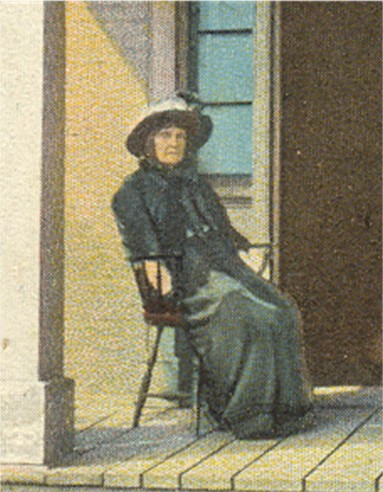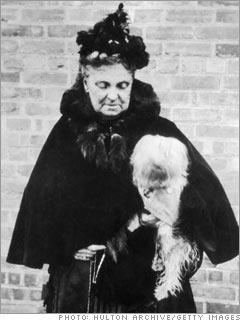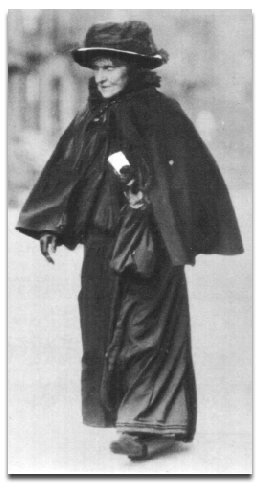- HubPages»
- Education and Science»
- History & Archaeology»
- History of the Americas
Hetty Green - The Witch of Wall Street

Some people take frugality to the limit. They scrounge and save and stretch. They calculate every move and every decision they make. Sacrifice becomes a virtue to them. It is a means to a desirable end. The end, of course, is money and wealth.. At what point are these frugal thinkers considered miserly, stingy or cheap? When does their eccentricity become mean-spirited obsession and undaunted greed? The answer is when they become like Hetty Green, the Witch of Wall Street.



Henrietta Howland Robinson was born in 1835 in New Bedford, Massachusetts. She was the daughter of wealthy owners of a very large whaling fleet. As a child, Hetty was smart, spoiled and curious. At six years old she was reading the financial section of newspapers to her father and grandfather whose eyesights were failing. Hetty opened her own savings account when she was eight years old. She did not make friends easily and had a hard time adjusting in school. When Hetty turned 21, she inherited nearly ten million dollars, the equivalent of 185 million in today's dollars,.from her parents. She turned her eye toward Wall Street and moved to New York.
It didn't take her long. Her shrewd business mind led Hetty to immediately begin investing in the financial markets. Her first success was when she purchased depreciated U.S, bonds from nervous investors after the Civil War. Her success didn't serve to make her a debutante in any circle. Her sour attitude repelled potential friends except for one of her father's business acquaintances by the name of Edward Henry Green. He was also a wealthy investor and both shared a love for money. They married in 1867 and moved to London where they had two children.
In their seven years in London, Hetty continued speculating in American dollars. They moved back to the U.S. in 1874 and settled in Green's boyhood home in the town of Bellow Falls, Vermont. They commuted regularly to New York to keep an eye on their investments. Hetty, already very rich, practised frugality to an extreme. She reused envelopes, haggled with merchants over prices and made sure only the hem of her dress was laundered at the cleaners. Maybe because of her thrift, Hetty accumulated wealth better than her husband did. When he tried to withdraw a large sum of money from their joint bank account and was refused because of an outstanding half a million dollar debt, Hetty had enough. She eventually paid his debt and ended the marriage.
Hetty Green conducted most of her business in the Seaboard National Bank in New York in subsequent years. She brought along her suitcases full of paperwork to avoid paying rent for an actual office. She invested her money in railroads and real estate and often lent money at a profit. The City of New York was several times the recipient of those loans. Hetty was known to travel thousands of miles to collect a few hundred dollar debt.
The Miser's Miser -
So how stingy was Hetty Green? She wore the same black dress and same undergarments every day. She moved around from one dingy hotel room or apartment to another never wanting to spend too much on rent. She bought broken cookies in bulk to get them cheaper. It is rumored Hetty spent hours searching her old car for a lost two cent stamp. She saved and combined shards of soap. She ate mostly oatmeal and crackers. She argued fiercely about every bill. Was Hetty Green just eccentric or down right mean?
She wasn't called the Witch of Wall Street for nothing. She would dig up dirt on any potential loan recipient or investor to keep the upper hand. She never turned on the heat or hot water. She ate raw onions for health and her general stench and black attire scared children. She sent her own children to school in hand-me-downs and lined their shoes and clothes with newspaper for warmth. The most damning act of her greed and meanness was when her son, Ned, injured his knee. Hetty tried to bring him to a charity hospital for treatment but was recognized and refused. She decided to treat his injury herself rather than spend the money on a doctor. A few years later her son's leg was amputated due to gangrene.
Hetty Green died on July 3, 1916 at the age of 81. She left all her money, a little under $200 million to her children. Her son, Ned, had her body transported from New York to Bellows Falls, Vermont in a private railroad car. She would have considered this a luxury for sure and would not have approved. Her children inherited her frugal ways as well though Ned was known to indulge in several interests such as auto racing and collectibles. Hetty's daughter, Sylvia, was more charitable.
Facts -
Hetty Green was the first female tycoon and the richest woman in America in her time. Her estate when she died, in today's economy, would have been worth $2 billion.
Books have been written about Hetty Green including The Day They Shook The Plum Tree by Arthur H. Lewis in 1963 and Hetty: The Genius and Madness of America's First Female Tycoons by Charles Slack in 2004.
Her family was related to the Howlands that came over on the Mayflower.
Hetty Green often travelled alone which was unheard of for women in those days.
In The Guinness Book of World Records Hetty Green is listed as one of the greatest misers in the world.
She feared assassination.
She was raised as a Quaker.
For other historic Hubs, please click here - http://hubpages.com/_36otspfnata5l/hub/Women-of-Computer-Science
And here - http://hubpages.com/_36otspfnata5l/hub/Cassie-Chadwick-Con-Artist








